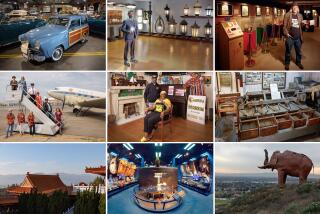Raise $3 Million to Expand? They Think They Can : Lomita: The railroad museum appears out of place in the quiet neighborhood. But it’s a point of pride for its supporters, who have ambitious plans for growth.
- Share via
Sure, the turn-of-the-century steam locomotive, weathered freight cars and Victorian station look out of place amid the tidy bungalows and white picket fences of the neighborhood around 250th Street and Woodward Avenue in Lomita.
After all, there is nary a railroad in sight. In fact, there never was a railroad in Lomita.
But the Lomita Railroad Museum, an almost surreal apparition off Narbonne Avenue, comes to life with a dose of imagination.
Overlook the fact that it is housed in a replica of a 19th-Century New England station instead of the real thing. Listen to the chugging steam locomotive--even if the huffing-and-puffing comes from a cassette recording. And envision the antique box and tanker cars rolling on the rails instead of standing idle, in sore need of paint, in a tiny park across from the museum.
“I know all of this stuff looks strange being here and not in some freight yard somewhere, but it’s good to let people know about the history,” said museum visitor Thaddeus Morris, 64, as he walked around the freight cars next to the museum. “And little Lomita needs something to cheer for.”
Now, the museum hopes to convert those cheers into contributions. Its directors have launched a $3-million fund-raising drive to double the size of the museum on adjacent land left to the museum by its founder, Irene Lewis, who lived next door until she died two years ago.
Aside from making the museum more prominent, the expansion would help ease the museum’s space crunch. It has collected some 1,500 pieces, but most are in storage because there is no room in the present building to display them.
Directors of the museum also hope the project will help draw more visitors so the museum can become self-sustaining, something the city of Lomita would prefer, said Michael Cozzolino, president of the museum’s board of directors.
Donated by Lewis to Lomita after she built it, the museum has an annual operating budget of about $70,000--all of which is paid by the city.
Cozzolino admits the museum’s $3-million fund-raising goal is lofty, but says it could be attained in a decade.
Officials hope to break ground on the first of two phases--a model train museum--within three years. If all goes well, another building housing more railroading artifacts would go up within 10 years.
“We know it’s going to be hard, and we figure it’s going to take a few years of hard work before we are able to put the first building up,” Cozzolino said.
For one thing, the museum must overcome its obscurity. People just don’t expect a museum to be smack in the middle of a quiet neighborhood.
“You get used to things, you know,” said Mary Winn, 87, whose family has lived in a house across the street for 50 years. “You adjust yourself to what’s there.”
Visitors, averaging about 12,000 a year, frequently tell tour guide Alice Abbott that they had to drive around and around before they finally found the place.
“It’s so hard to find, for a lot of people,” said Abbott, who has been with the museum since its opening in 1967.
But once there, visitors enter a world of railroad nostalgia.
All the museum pieces, from the 80-ton 1902 Southern Pacific steam locomotive to the old trainmen’s uniform buttons, were brought together by Lewis, a feisty widow who inherited her husband’s model railroading business and built the museum in his honor.
Inside the musty wooden caboose on display, grainy photographs show old train yards near Los Angeles Harbor in 1919 and commemorative celebrations of the completion of the transcontinental railroad at Promontory Point, Utah.
The main attraction is an iron steam locomotive and tender once used for runs between Los Angeles and San Bernardino.
Before she had acquired a single piece of railroad memorabilia, Lewis had planned the kind of building she wanted for her station--not a California-style simple adobe building, but rather a grand Victorian style, like those in New England.
Enchanted by a picture of the depot in Wakefield, Mass., Lewis fired four architects before John Gallareto of Lomita got the design right.
Yet she still had no museum pieces.
“I’ve done a lot of things backward in my life,” Lewis told an interviewer in 1966, dismissing critics who doubted the project would get off the ground. “Who says you must be a collector before you build a museum?”
She confounded skeptics by acquiring a steam locomotive--donated by a Terminal Island scrap yard with the caveat that Lewis pay for its removal--and the caboose and other memorabilia from various railroads. Private collectors also loaned pieces--old tickets, schedules, equipment.
People continue to donate and the museum keeps collecting in hopes of future expansion. A railroad bell, for instance, is likely to be on the way later this year, Abbott said.
Cozzolino said numerous fund-raisers are being planned. Only a few thousand dollars have been raised since the kickoff two months ago. “That’s not much, but we are just in the primitive stages now,” he said.
Cozzolino added: “It’s the only thing Lomita has in the Southern California AAA sightseeing guide book, and a lot of us wanted it to be something to be proud of.”
More to Read
Sign up for The Wild
We’ll help you find the best places to hike, bike and run, as well as the perfect silent spots for meditation and yoga.
You may occasionally receive promotional content from the Los Angeles Times.






